编著:梁守渝 Mri D. Ngo 来源:中国散手快摔 演示:梁守渝 Chapter 3 Basic Trainin With Equipment 用具基本訓練 3-1. Introduction Chinese martial arts emphasize basic technique training and body conditioning. It is not hard to understand that body conditioning is nec-essary for the strength, power and endurance that makes your tech-niques more powerful. Without basic conditioning, the techniques you learn will not be as effective as they should. There is a saying often heard among Chinese martial artists: "One power suppresses ten techniques"(Yi Li Xiang Shi hui, 一力降十會). It simply means that power can over-come technique. There are different forms of power such as External (Li, physical, muscular) power, Internal (Qi) power, and Mental power. Although there are different forms of power, they are related and it is hard to distinguish between them or separate them one from another. When applying the throwing techniques of San Shou Kuai Jiao, the power of your hands and arms is very important. Your hands must be able to grab tightly, and your arms should have enough strength and resistance for blocking. When holding or carrying an opponent on your back you need to have power and strength in your waist and legs. The waist and legs need to be strong and flexible in order to make your body movements smooth and swift. When your hands, arms, waist and legs have strength and power, then techniques will become much more effec-tive, and mentally, your confidence will be higher. As a result, you can maximize your fighting ability. In this chapter, we will introduce some of the traditional equipment training methods to help you to develop the skills and power necessary for San Shou Kuai Jiao techniques. These methods are simple, refined, and very effective for improving the endurance and power of the whole body. These training methods,which have been passed down from generation to generation, are neces-sary if you want to become profi-cient in San Shou Kuai Jiao. It is impossible to list all the training methods developed for San Shou Kuai Jiao, but the techniques in this chapter will provide you with a strong and well-rounded foundation. If you are interested in other traditional training methods, please refer to the forthcoming traditional Chinese Shuai Jiao book from YMAA Publication Center. 3-2- Body Conditioning With Equipment 1.Windlass雙手卷棒 To increase the strength and power of the wrists and forearms. Equipment: A five to ten pound weight suspended by a cord from the center of a short wooden bar (Figure 3-1). Training Method: Squat down in Horse Stance or stand with both feet shoulder width apart. With both hands, hold the bar straight out at shoul-der height. Wind the cord onto the bar until the weight reaches the bar. Then unwind the cord to lower the weight. Repeat the exercise and gradually increase the number of repetitions and the amount of weight (Figures 3-2 and 3-3). 2. Single Hand Windlass單手卷棒 To increase the strength and power of the wrists and forearms.Also increases the grabbing strength of the hands. Equipment: A two to six pound weight sus-pended by a cord from the cen-ter of a short wooden bar. Training Method: Stand up with both feet shoul-der width apart. With one hand grab an end of the bar (Figure 3-4), and turn your wrist so that the other end of the bar will turn motion (Figure 3-5). Every time you turn the bar downward, it will scoop up the cord and Iift the weight (Figure 3-6). Wind the cord onto the bar until the weight is all the way up (Figure 3-7). You must turn your wrist quickly so the cord does not unwind. Repeat the same exercise with the other hand, and gradually increase the number of repetitions and the amount of weight. 3. Tossing the Sand Bag扔沙袋 To increase your squeezing, grabbing, and pulling power. Also to increase body movement coordination. Equipment: Use fine canvas to make a bag about 16x16 inches. Fill the bag about one third of the way with sand. Gradually add more sand as your strength increases. Training Method: A.SOLO PRACTICE Tossing Left and Right: Stand with both feet shoulder width apart and knees slightly bent. With your left hand grab the sand bag at its center (Figure3-8) and throw it up above your head to your right (Figure 3-9).Then grab the center of the bag with your right hand while it is still in the air. Then throw it up to your left (Figure 3-10). Repeat as many times as you want. When you are comfortable with the exercise, you can add footwork like Front Cross Step and Back Cross Step while you throw and grab the bag. Make sure to grab the bag's center. Tossing Around the Back: Stand up with both feet shoulder width apart and your knees slightly bent. With your right hand grab the bag and toss it behind your back and over your head so it will be in front of you to your left. Grab the bag in the air with your left hand and toss it to the right over your head so it will be in front of you to your right. Grab the bag with the right hand and repeat the exercise (Figures 3-11 and 3-12). When you are comfortable with this exercise, you can add footwork while you toss and grab the bag. Tossing Between the Legs: Stand in Horse Stance. Grab the bag with your right hand and toss it up between both legs from outside of you right leg(Figures-3-15)and then toss it up between both legs from the outside of the left leg. Grab the bag with the right hand and repeat the exercise. B.TWO PERSON EXERCISE: Two persons face each other. Your partner tosses the bag and you catch it with your right hand. Then toss it up above your head to your left (Figures 3-16 and 3-17). Grab the bag at its cen-ter with your left hand while it is still in the air (Figure 3-18). Toss the bag back to your right hand and throw it back to your part-ner (Figures 3-19 and 3-20). Adjust your distance accordingly. You can throw directly to each other, from behind your back to each other, or between the legs to each other. Be creative and have fun with this exercise. 4. Weight Training舉重 To increase the strength of the limbs and improve waist power and other powers such as lifting and thrusting through. Also develops body coordination and endurance. Equipment: Traditionally, the weight was a stone between 20 and 100 pounds.Modern weight lifting equipment is acceptable (Figure 3-21). Training Methods: A. BOTH HANDS PUSH FORWARD: Stand in Horse Stance, lift the weight up and push it out in front of your chest at shoulder height (Figures 3-22 and 3-23). Then pull the weight in and repeat as many times as you want (Figure3-24). B. WHEELING THE WEIGHT: Left Side: Stand up with both feet shoulder width apart and bend slightly at the knees. Hold the weight in front of you with your right palm turned outward and left palm turned inward (Figure 3-25). Back view (Figure 3-26). Step with your left foot behind and across your right foot (Figure3-27) and swing the weight upward in a circular motion. Lead with the left hand and pivot 180 degrees, holding the weight above your head (Figure 3-28). Continuing from Figure 3-28 above, step with your left footbehind and across the right foot and swing the weight downward in a circular motion as you pivot from your waist 180 degrees and back to the original form (Figures 3-29,3-30, and 3-31). Repeat the exercise and gradually increase the weight and number of repeti-tions. Be sure that the dumbbells are securely fastened to the bar, and do not swing wildly. Right Side: Repeat the same exercises in the opposite direction 5. Pulling Elastic Rope 扯橡皮筋 Pulling elastic rope is another basic of Chinese Wrestling train-ing. It is convenient because you can bring the rope with you to practice where and when you want. This training will help to increase the strength and mobility of the whole body. Elastic rope pulling is often practiced in combination with basic wrestling moves to improve the accuracy and fluency of the techniques. Equipment: Traditionally, the equipment consists of pulleys with weights tied at one end of the rope. The weight should vary according to your ability. Elastic rope can also now be used. Tie the rope so that it has one long section joined by two shorter sections. The long section should be two or three times longer. The two shorter sections are for both hands to pull. When practicing, tie the longer end of the rope to a pole or tree. Make sure the rope is secure before using it(Figure 3-32). Training Method: Stand with both feet shoulder width apart. Grab both short ends of the rope in your left hand and stand sideways with your right shoulder facing the pole (Figure3-33). Pull the rope in front of you and past your body to your left. Follow the pulling hand with your eyes. Repeat the exercise and gradually increase the num-ber of repetitions. (Figure 3-34). Change sides and repeat with the right hand. B. PULLING DOWNWARD SIDEWAYS: Grab the short ends of the rope with both hands and face the pole with right leg forward (Figure 3-35). Step the right foot across the left foot while pulling the rope down to the left with both hands. Repeat the exercise and gradually increase the number of repetitions. (Figure 3-36). Change sides and repeat. C.PULL AND THRUST FORWARD: Stand with both feet shoulder width apart, grab both ends of the rope with the right hand and face the pole sideways (Figure 3-37). Pull the rope to your left in front of you. When it passes your body, twist and push into a Left Bow Stance. The right hand thrusts for- ward and extends as far as possible while you look back to the left. Repeat the exercise and gradually increase the number of rep-etitions (Figure 3-38). Change sides and repeat. D. EXTENDING THE BODY: Stand with both feet shoulder width apart with the right side of your body facing the pole. Grab both ends of the rope with your left hand and pull it around your back. Hook the rope with your right arm at the inside crook of your elbow (Figure 3-39). Twist your whole body to the left into Left Bow Stance. The right arm pulls forward to the left. Repeat the exercise and gradually increase the number of repetitions (Figure 3-40). Change sides and repeat. E. PULLING lN BOTH DIRECTIONS: Squat down in Horse Stance.Each hand grabs an end of the rope and pulls it in front of you out to the sides and then return to3-42). Repeat the exercise and gradually increase the number of repeti-tions. F. PULL AND KICK: Squat down in Horse Stance and grab both ends of the rope, one in each hand. Pull the rope down to your left. Simul-taneously kick with the left leg, keeping the toes locked back (Figure 3-43). Change to right side and repeat in the opposite direction (Figure 3-44). While you are kicking, keep the stand-ing leg bent for balance and rooting training. Repeat the exercise and gradual-ly increase the number of repeti-tions. G. LEG HOOKING, BLOCKIN6 TRAINING: Stand with your right foot for-ward (Figure 3-45). Grab the ends of the rope with both hands and pull down to your left. Simultaneously, step your left foot behind your right foot (Figure 3-46). Keep pulling the rope and raise both hands in front of your chest (Figure 3-47).Then twist your body to your left 180 degrees, and kick back and upward in a circular motion with your right leg as high as you can. Keep pulling the rope to your left with your left hand and With the rinht hand keep pulling the rope forward then down-ward in front of you. Your eyes should look back to the left (Figure 3-48). Repeat this xercise as many times sa you want. Change sides and repeat. H. LOWER LE6 BLOCKING, ARMS PULLING AND SHOULDER PRESSING TRAINING: Face the pole and pull the rope towards you with both hands(Figure 3-49). Step forward with your right foot (Figure 3-50). Step back and around the right foot with your left. Your back should now face the pole (Figure3-51). Twist and extend your body into a Left Bow Stance and extend your right leg out for a leg block while looking back to your left. Pull the rope upward over your head and then down to your front with your left hand. Simultaneously, pull the rope with your right hand for-ward to the left(Figure 3-52). Both hands should pull the rope at the same time in a circular motion. Repeat this exercise as many times as you want. Change sides and repeat. I. FRONT CROSS STEP. CARRYING OVER THE SHOULDER RTAINING: This is a typical training method for hip throwing techniques. Stand with both legs shoulder width apart and slightly bent. Grab the ends of the rope with both hands (Figure 3-53). Step with your right foot across and in front of your left (Figure 3-54). Keeping the legs bent, pivot to the left on the balls of your feet and pull the rope up to your left shoulder (Figure 3-55). Pull the rope down over the shoulder in a circular motion with both hands. Bend at the waist and bow forward deeply. Simultaneously, spring up with both knees. Remember to keep your head tucked in (Figure 3-56). Repeat the exercise as many times as you want, and then change sides. J.BACK CROSS STEP, CARRYING OVER THE SHOULDER TRAINING: This training is the same as Front Cross Step, Carrying Over the Shoulder Training except for the foot work. Instead of stepping in front of the other foot, step across and behind. Feel free to experiment with the foot work when training this exercise. 
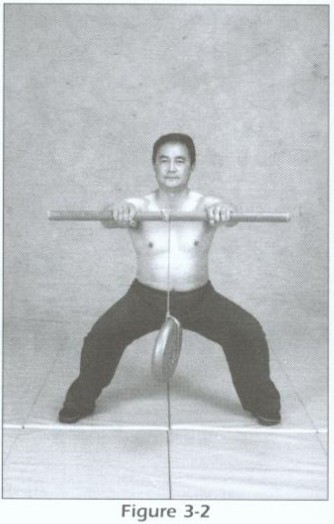
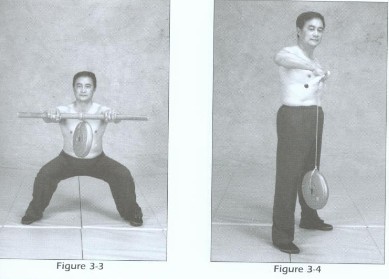
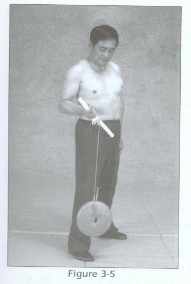
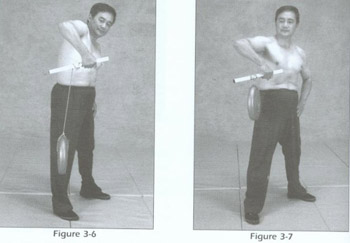

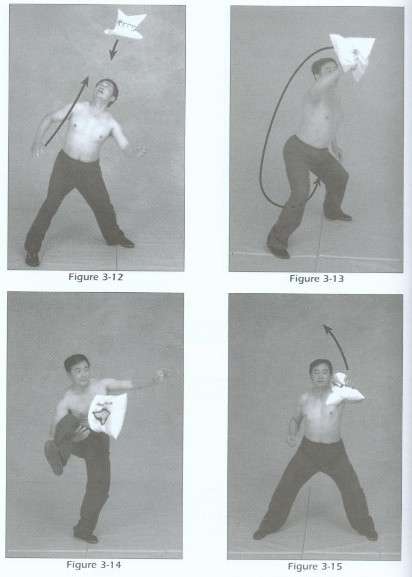
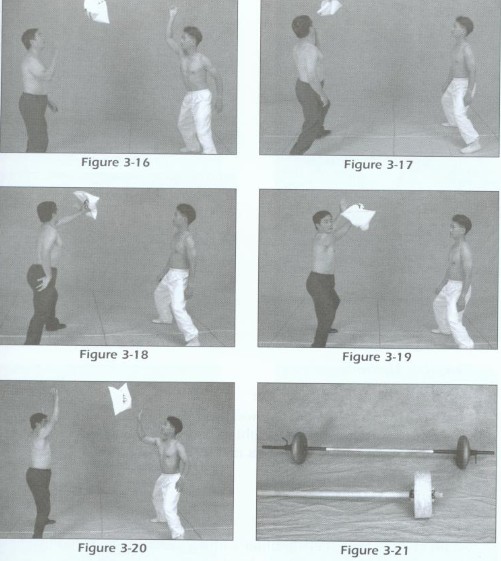



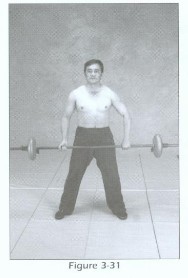
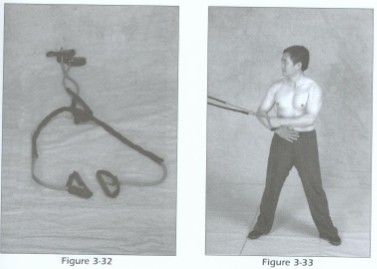
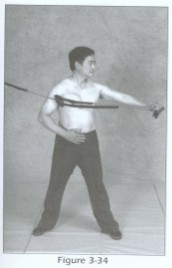
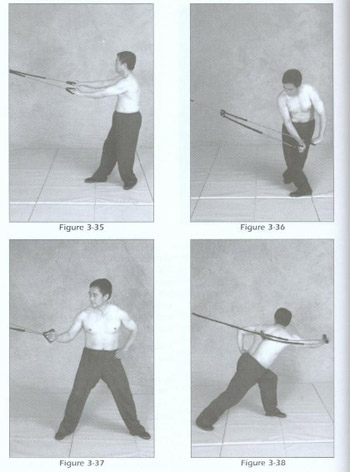
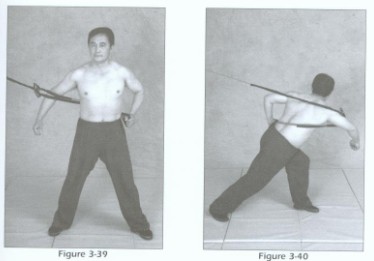


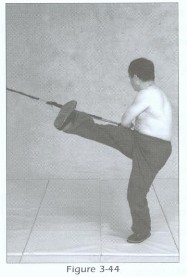


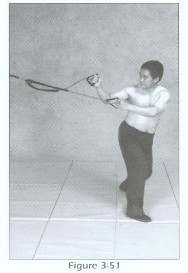



 3-2- Body Conditioning With Equipment1.Windlass雙手卷棒To increase the strength and power of the wrists and forearms.Equipment:A five to ten pound weight suspended by a cord from the center of a short wooden bar (Figure 3-1).Training Method:Squat down in Horse Stance or stand with both feet shoulder width apart. With both hands, hold the bar straight out at shoul-der height. Wind the cord onto the bar until the weight reaches the bar. Then unwind the cord to lower the weight. Repeat the exercise and gradually increase the number of repetitions and the amount of weight (Figures 3-2 and 3-3).2. Single Hand Windlass單手卷棒To increase the strength and power of the wrists and forearms.Also increases the grabbing strength of the hands.Equipment:A two to six pound weight sus-pended by a cord from the cen-ter of a short wooden bar.Training Method:Stand up with both feet shoul-der width apart. With one hand grab an end of the bar (Figure 3-4), and turn your wrist so that the other end of the bar will turn motion (Figure 3-5). Every time you turn the bar downward, it will scoop up the cord and Iift the weight (Figure 3-6). Wind the cord onto the bar until the weight is all the way up (Figure 3-7). You must turn your wrist quickly so the cord does not unwind. Repeat the same exercise with the other hand, and gradually increase the number of repetitions and the amount of weight.
3-2- Body Conditioning With Equipment1.Windlass雙手卷棒To increase the strength and power of the wrists and forearms.Equipment:A five to ten pound weight suspended by a cord from the center of a short wooden bar (Figure 3-1).Training Method:Squat down in Horse Stance or stand with both feet shoulder width apart. With both hands, hold the bar straight out at shoul-der height. Wind the cord onto the bar until the weight reaches the bar. Then unwind the cord to lower the weight. Repeat the exercise and gradually increase the number of repetitions and the amount of weight (Figures 3-2 and 3-3).2. Single Hand Windlass單手卷棒To increase the strength and power of the wrists and forearms.Also increases the grabbing strength of the hands.Equipment:A two to six pound weight sus-pended by a cord from the cen-ter of a short wooden bar.Training Method:Stand up with both feet shoul-der width apart. With one hand grab an end of the bar (Figure 3-4), and turn your wrist so that the other end of the bar will turn motion (Figure 3-5). Every time you turn the bar downward, it will scoop up the cord and Iift the weight (Figure 3-6). Wind the cord onto the bar until the weight is all the way up (Figure 3-7). You must turn your wrist quickly so the cord does not unwind. Repeat the same exercise with the other hand, and gradually increase the number of repetitions and the amount of weight.  3. Tossing the Sand Bag扔沙袋To increase your squeezing, grabbing, and pulling power. Also to increase body movement coordination.Equipment:Use fine canvas to make a bag about 16x16 inches. Fill the bag about one third of the way with sand. Gradually add more sand as your strength increases.Training Method:A.SOLO PRACTICETossing Left and Right:Stand with both feet shoulder width apart and knees slightly bent. With your left hand grab the sand bag at its center (Figure3-8) and throw it up above your head to your right (Figure 3-9).Then grab the center of the bag with your right hand while it is still in the air. Then throw it up to your left (Figure 3-10). Repeat as many times as you want. When you are comfortable with the exercise, you can add footwork like Front Cross Step and Back Cross Step while you throw and grab the bag. Make sure to grab the bag's center.Tossing Around the Back:Stand up with both feet shoulder width apart and your knees slightly bent. With your right hand grab the bag and toss it behind your back and over your head so it will be in front of you to your left. Grab the bag in the air with your left hand and toss it to the right over your head so it will be in front of you to your right. Grab the bag with the right hand and repeat the exercise (Figures 3-11 and 3-12). When you are comfortable with this exercise, you can add footwork while you toss and grab the bag.
3. Tossing the Sand Bag扔沙袋To increase your squeezing, grabbing, and pulling power. Also to increase body movement coordination.Equipment:Use fine canvas to make a bag about 16x16 inches. Fill the bag about one third of the way with sand. Gradually add more sand as your strength increases.Training Method:A.SOLO PRACTICETossing Left and Right:Stand with both feet shoulder width apart and knees slightly bent. With your left hand grab the sand bag at its center (Figure3-8) and throw it up above your head to your right (Figure 3-9).Then grab the center of the bag with your right hand while it is still in the air. Then throw it up to your left (Figure 3-10). Repeat as many times as you want. When you are comfortable with the exercise, you can add footwork like Front Cross Step and Back Cross Step while you throw and grab the bag. Make sure to grab the bag's center.Tossing Around the Back:Stand up with both feet shoulder width apart and your knees slightly bent. With your right hand grab the bag and toss it behind your back and over your head so it will be in front of you to your left. Grab the bag in the air with your left hand and toss it to the right over your head so it will be in front of you to your right. Grab the bag with the right hand and repeat the exercise (Figures 3-11 and 3-12). When you are comfortable with this exercise, you can add footwork while you toss and grab the bag.
 Tossing Between the Legs: Stand in Horse Stance. Grab the bag with your right hand and toss it up between both legs from outside of you right leg(Figures-3-15)and then toss it up between both legs from the outside of the left leg. Grab the bag with the right hand and repeat the exercise.B.TWO PERSON EXERCISE:Two persons face each other. Your partner tosses the bag and you catch it with your right hand. Then toss it up above your head to your left (Figures 3-16 and 3-17). Grab the bag at its cen-ter with your left hand while it is still in the air (Figure 3-18). Toss the bag back to your right hand and throw it back to your part-ner (Figures 3-19 and 3-20). Adjust your distance accordingly. You can throw directly to each other, from behind your back to each other, or between the legs to each other. Be creative and have fun with this exercise.
Tossing Between the Legs: Stand in Horse Stance. Grab the bag with your right hand and toss it up between both legs from outside of you right leg(Figures-3-15)and then toss it up between both legs from the outside of the left leg. Grab the bag with the right hand and repeat the exercise.B.TWO PERSON EXERCISE:Two persons face each other. Your partner tosses the bag and you catch it with your right hand. Then toss it up above your head to your left (Figures 3-16 and 3-17). Grab the bag at its cen-ter with your left hand while it is still in the air (Figure 3-18). Toss the bag back to your right hand and throw it back to your part-ner (Figures 3-19 and 3-20). Adjust your distance accordingly. You can throw directly to each other, from behind your back to each other, or between the legs to each other. Be creative and have fun with this exercise. 4. Weight Training舉重To increase the strength of the limbs and improve waist power and other powers such as lifting and thrusting through. Also develops body coordination and endurance.Equipment:Traditionally, the weight was a stone between 20 and 100 pounds.Modern weight lifting equipment is acceptable (Figure 3-21).
4. Weight Training舉重To increase the strength of the limbs and improve waist power and other powers such as lifting and thrusting through. Also develops body coordination and endurance.Equipment:Traditionally, the weight was a stone between 20 and 100 pounds.Modern weight lifting equipment is acceptable (Figure 3-21). Training Methods:A. BOTH HANDS PUSH FORWARD:Stand in Horse Stance, lift the weight up and push it out in front of your chest at shoulder height (Figures 3-22 and 3-23). Then pull the weight in and repeat as many times as you want (Figure3-24).B. WHEELING THE WEIGHT:Left Side:Stand up with both feet shoulder width apart and bend slightly at the knees. Hold the weight in front of you with your right palm turned outward and left palm turned inward (Figure 3-25). Back view (Figure 3-26).Step with your left foot behind and across your right foot (Figure3-27) and swing the weight upward in a circular motion. Lead with the left hand and pivot 180 degrees, holding the weight above your head (Figure 3-28).Continuing from Figure 3-28 above, step with your left footbehind and across the right foot and swing the weight downward in a circular motion as you pivot from your waist 180 degrees and back to the original form (Figures 3-29,3-30, and 3-31). Repeat the exercise and gradually increase the weight and number of repeti-tions. Be sure that the dumbbells are securely fastened to the bar, and do not swing wildly.
Training Methods:A. BOTH HANDS PUSH FORWARD:Stand in Horse Stance, lift the weight up and push it out in front of your chest at shoulder height (Figures 3-22 and 3-23). Then pull the weight in and repeat as many times as you want (Figure3-24).B. WHEELING THE WEIGHT:Left Side:Stand up with both feet shoulder width apart and bend slightly at the knees. Hold the weight in front of you with your right palm turned outward and left palm turned inward (Figure 3-25). Back view (Figure 3-26).Step with your left foot behind and across your right foot (Figure3-27) and swing the weight upward in a circular motion. Lead with the left hand and pivot 180 degrees, holding the weight above your head (Figure 3-28).Continuing from Figure 3-28 above, step with your left footbehind and across the right foot and swing the weight downward in a circular motion as you pivot from your waist 180 degrees and back to the original form (Figures 3-29,3-30, and 3-31). Repeat the exercise and gradually increase the weight and number of repeti-tions. Be sure that the dumbbells are securely fastened to the bar, and do not swing wildly.

 Right Side:Repeat the same exercises in the opposite direction5. Pulling Elastic Rope 扯橡皮筋Pulling elastic rope is another basic of Chinese Wrestling train-ing. It is convenient because you can bring the rope with you to practice where and when you want. This training will help to increase the strength and mobility of the whole body. Elastic rope pulling is often practiced in combination with basic wrestling moves to improve the accuracy and fluency of the techniques.
Right Side:Repeat the same exercises in the opposite direction5. Pulling Elastic Rope 扯橡皮筋Pulling elastic rope is another basic of Chinese Wrestling train-ing. It is convenient because you can bring the rope with you to practice where and when you want. This training will help to increase the strength and mobility of the whole body. Elastic rope pulling is often practiced in combination with basic wrestling moves to improve the accuracy and fluency of the techniques. 
 Equipment:Traditionally, the equipment consists of pulleys with weights tied at one end of the rope. The weight should vary according to your ability. Elastic rope can also now be used. Tie the rope so that it has one long section joined by two shorter sections. The long section should be two or three times longer. The two shorter sections are for both hands to pull. When practicing, tie the longer end of the rope to a pole or tree. Make sure the rope is secure before using it(Figure 3-32).Training Method:Stand with both feet shoulder width apart. Grab both short ends of the rope in your left hand and stand sideways with your right shoulder facing the pole (Figure3-33). Pull the rope in front of you and past your body to your left. Follow the pulling hand with your eyes. Repeat the exerciseand gradually increase the num-ber of repetitions. (Figure 3-34). Change sides and repeat with the right hand.B. PULLING DOWNWARDSIDEWAYS:Grab the short ends of the rope with both hands and face the pole with right leg forward (Figure 3-35). Step the right foot across the left foot while pullingthe rope down to the left with both hands. Repeat the exercise and gradually increase the number of repetitions. (Figure 3-36). Change sides and repeat.C.PULL AND THRUST FORWARD:Stand with both feet shoulder width apart, grab both ends of the rope with the right hand and face the pole sideways (Figure 3-37).Pull the rope to your left in front of you. When it passes your body, twist and push into a Left Bow Stance. The right hand thrusts for- ward and extends as far as possible while you look back to the left. Repeat the exercise and gradually increase the number of rep-etitions (Figure 3-38).
Equipment:Traditionally, the equipment consists of pulleys with weights tied at one end of the rope. The weight should vary according to your ability. Elastic rope can also now be used. Tie the rope so that it has one long section joined by two shorter sections. The long section should be two or three times longer. The two shorter sections are for both hands to pull. When practicing, tie the longer end of the rope to a pole or tree. Make sure the rope is secure before using it(Figure 3-32).Training Method:Stand with both feet shoulder width apart. Grab both short ends of the rope in your left hand and stand sideways with your right shoulder facing the pole (Figure3-33). Pull the rope in front of you and past your body to your left. Follow the pulling hand with your eyes. Repeat the exerciseand gradually increase the num-ber of repetitions. (Figure 3-34). Change sides and repeat with the right hand.B. PULLING DOWNWARDSIDEWAYS:Grab the short ends of the rope with both hands and face the pole with right leg forward (Figure 3-35). Step the right foot across the left foot while pullingthe rope down to the left with both hands. Repeat the exercise and gradually increase the number of repetitions. (Figure 3-36). Change sides and repeat.C.PULL AND THRUST FORWARD:Stand with both feet shoulder width apart, grab both ends of the rope with the right hand and face the pole sideways (Figure 3-37).Pull the rope to your left in front of you. When it passes your body, twist and push into a Left Bow Stance. The right hand thrusts for- ward and extends as far as possible while you look back to the left. Repeat the exercise and gradually increase the number of rep-etitions (Figure 3-38). 

 Change sides and repeat.D. EXTENDING THE BODY:Stand with both feet shoulder width apart with the right side of your body facing the pole. Grab both ends of the rope with your left hand and pull it around your back. Hook the rope with your right arm at the inside crook of your elbow (Figure 3-39). Twist your whole body to the left into Left Bow Stance. The right arm pulls forward to the left. Repeat the exercise and gradually increase the number of repetitions (Figure 3-40).Change sides and repeat.E. PULLING lN BOTHDIRECTIONS:Squat down in Horse Stance.Each hand grabs an end of the rope and pulls it in front of you out to the sides and then return to3-42).
Change sides and repeat.D. EXTENDING THE BODY:Stand with both feet shoulder width apart with the right side of your body facing the pole. Grab both ends of the rope with your left hand and pull it around your back. Hook the rope with your right arm at the inside crook of your elbow (Figure 3-39). Twist your whole body to the left into Left Bow Stance. The right arm pulls forward to the left. Repeat the exercise and gradually increase the number of repetitions (Figure 3-40).Change sides and repeat.E. PULLING lN BOTHDIRECTIONS:Squat down in Horse Stance.Each hand grabs an end of the rope and pulls it in front of you out to the sides and then return to3-42). 
 Repeat the exercise and gradually increase the number of repeti-tions.F. PULL AND KICK:Squat down in Horse Stance and grab both ends of the rope, one in each hand. Pull the rope down to your left. Simul-taneously kick with the left leg, keeping the toes locked back (Figure 3-43). Change to right side and repeat in the opposite direction (Figure 3-44). While you are kicking, keep the stand-ing leg bent for balance androoting training.Repeat the exercise and gradual-ly increase the number of repeti-tions.G. LEG HOOKING, BLOCKIN6TRAINING:Stand with your right foot for-ward (Figure 3-45). Grab the ends of the rope with both hands and pull down to your left. Simultaneously, step your left foot behind your right foot (Figure 3-46). Keep pulling the rope and raise both hands in front of your chest (Figure 3-47).Then twist your body to your left 180 degrees, and kick back and upward in a circular motion with your right leg as high as you can. Keep pulling the rope to your left with your left hand and With the rinht hand keep pulling the rope forward then down-ward in front of you. Your eyes should look back to the left (Figure 3-48). Repeat this xercise as many times sa you want. Change sides and repeat.
Repeat the exercise and gradually increase the number of repeti-tions.F. PULL AND KICK:Squat down in Horse Stance and grab both ends of the rope, one in each hand. Pull the rope down to your left. Simul-taneously kick with the left leg, keeping the toes locked back (Figure 3-43). Change to right side and repeat in the opposite direction (Figure 3-44). While you are kicking, keep the stand-ing leg bent for balance androoting training.Repeat the exercise and gradual-ly increase the number of repeti-tions.G. LEG HOOKING, BLOCKIN6TRAINING:Stand with your right foot for-ward (Figure 3-45). Grab the ends of the rope with both hands and pull down to your left. Simultaneously, step your left foot behind your right foot (Figure 3-46). Keep pulling the rope and raise both hands in front of your chest (Figure 3-47).Then twist your body to your left 180 degrees, and kick back and upward in a circular motion with your right leg as high as you can. Keep pulling the rope to your left with your left hand and With the rinht hand keep pulling the rope forward then down-ward in front of you. Your eyes should look back to the left (Figure 3-48). Repeat this xercise as many times sa you want. Change sides and repeat.

 H. LOWER LE6 BLOCKING,ARMS PULLING AND SHOULDER PRESSING TRAINING:Face the pole and pull the rope towards you with both hands(Figure 3-49). Step forward with your right foot (Figure 3-50). Step back and around the right foot with your left. Your back should now face the pole (Figure3-51). Twist and extend your body into a Left Bow Stance and extend your right leg out for a leg block while looking back to your left. Pull the rope upward over your head and then down to your front with your left hand. Simultaneously, pull the rope with your right hand for-ward to the left(Figure 3-52). Both hands should pull the rope at the same time in a circular motion. Repeat this exercise as many times as you want. Change sides andrepeat.I.FRONT CROSS STEP. CARRYING OVER THE SHOULDER RTAINING:This is a typical training method for hip throwing techniques. Stand with both legs shoulder width apart and slightly bent. Grab
H. LOWER LE6 BLOCKING,ARMS PULLING AND SHOULDER PRESSING TRAINING:Face the pole and pull the rope towards you with both hands(Figure 3-49). Step forward with your right foot (Figure 3-50). Step back and around the right foot with your left. Your back should now face the pole (Figure3-51). Twist and extend your body into a Left Bow Stance and extend your right leg out for a leg block while looking back to your left. Pull the rope upward over your head and then down to your front with your left hand. Simultaneously, pull the rope with your right hand for-ward to the left(Figure 3-52). Both hands should pull the rope at the same time in a circular motion. Repeat this exercise as many times as you want. Change sides andrepeat.I.FRONT CROSS STEP. CARRYING OVER THE SHOULDER RTAINING:This is a typical training method for hip throwing techniques. Stand with both legs shoulder width apart and slightly bent. Grab 
 Repeat the exercise as many times as you want, and then change sides.J.BACK CROSS STEP, CARRYING OVER THE SHOULDER TRAINING:This training is the same as Front Cross Step, Carrying Over the Shoulder Trainingexcept for the foot work. Instead of stepping in front of the other foot, step across and behind. Feel free to experiment with the foot work when training this exercise.
Repeat the exercise as many times as you want, and then change sides.J.BACK CROSS STEP, CARRYING OVER THE SHOULDER TRAINING:This training is the same as Front Cross Step, Carrying Over the Shoulder Trainingexcept for the foot work. Instead of stepping in front of the other foot, step across and behind. Feel free to experiment with the foot work when training this exercise.




发表评论: